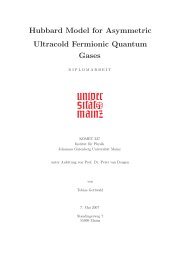5 Hirsch-Fye quantum Monte Carlo method for ... - komet 337
5 Hirsch-Fye quantum Monte Carlo method for ... - komet 337
5 Hirsch-Fye quantum Monte Carlo method for ... - komet 337
Create successful ePaper yourself
Turn your PDF publications into a flip-book with our unique Google optimized e-Paper software.
<strong>Hirsch</strong>-<strong>Fye</strong> QMC 5.9<br />
(a) (b)<br />
1<br />
0.8<br />
0.6<br />
0.4<br />
0.2<br />
0<br />
-1 -0.5 0 0.5 1<br />
x<br />
f(x)<br />
MC<br />
I est<br />
1.4<br />
1.2<br />
1<br />
I est<br />
1.27<br />
1.26<br />
0.8 exact<br />
trapezoid<br />
simple MC<br />
0 0.01<br />
1/N<br />
0.6<br />
0 20 40 60 80 100<br />
2<br />
Fig. 3: Illustration of simple MC: (a) instead of using deterministic quadrature schemes such<br />
as the trapezoid rule, integrals over some function f(x) can be evaluated by averaging over<br />
function values f(xi) of stocastically generated support points xi (and multiplying by the integration<br />
volume). (b) The resulting statistical error decreases as 1/ √ N with the number of<br />
function evaluations (crosses and error bars). The deterministic trapezoid discretization scheme<br />
(circles) converges with an error proportional to N −2/d , i.e., is superior in dimensions d < 4;<br />
furthermore, an extrapolation of the systematic error is straight<strong>for</strong>ward (inset).<br />
where we may regard pl as a (unnormalized) probability distribution <strong>for</strong> the indices and ol as<br />
a remaining observable. If both the normalization c is known (i.e, the sum over the weights pl<br />
can be per<strong>for</strong>med exactly) and the corresponding probability distribution can be realized (by<br />
drawing indicesl with probabilityP(l) = pl/c), we obtain<br />
X MC<br />
imp = c<br />
N<br />
N�<br />
j=1<br />
olj and ∆X MC<br />
�<br />
vo<br />
imp = c . (26)<br />
N<br />
Thus, the error can be reduced (vo < c 2 vx), when the problem is partially solvable, i.e., the<br />
sum over pl with pl ≈ xl can be computed. 10 Since this is not possible in general, one usually<br />
has to treat the normalization c as an unknown and realize the probability distributionP(lj) =<br />
plj /c in a stochastic Markov process: Starting with some initial configuration l1, a chain of<br />
configurations is built up where in each step only a small subset of configurationsl ′ is accessible<br />
in a “transition” from configuration l. Provided that the transition rules satisfy the detailed<br />
balance principle,<br />
plP(l → l ′ ) = pl ′P(l′ → l), (27)<br />
and the process is ergodic (i.e., all configurations can be reached from some starting configuration),<br />
the distribution of configurations of the chain approaches the target distribution in the<br />
limit of infinite chain length, as illustrated in Fig. 4. Since the normalization remains unknown,<br />
importance sampling by a Markov process can only yield ratios of different observables evaluated<br />
on the same chain of configurations. Another consequence of using a Markov process is<br />
that initial configurations have to be excluded from averages since the true associated probabil-<br />
10 The possible reduction of the variance is limited when xl is of varying sign. This “minus-sign problem”<br />
seriously restricts the applicability of <strong>Monte</strong> <strong>Carlo</strong> <strong>method</strong>s <strong>for</strong> finite-dimensional fermion problems.<br />
N













